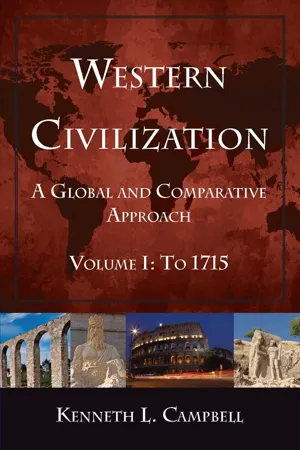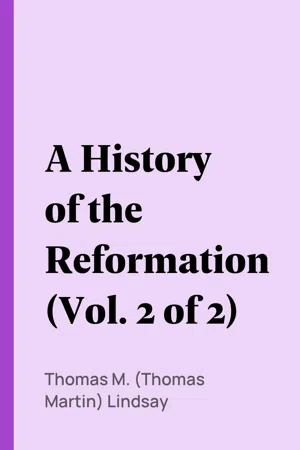History
Roman Catholic Church 1500s
In the 1500s, the Roman Catholic Church was a dominant religious and political force in Europe. It faced challenges from the Protestant Reformation, which led to a significant division within Christianity. The Church also experienced internal reforms, such as the Council of Trent, aimed at addressing corruption and strengthening its authority.
Written by Perlego with AI-assistance
Related key terms
4 Key excerpts on "Roman Catholic Church 1500s"
- eBook - ePub
Western Civilization: A Global and Comparative Approach
Volume I: To 1715
- Kenneth L. Campbell(Author)
- 2014(Publication Date)
- Routledge(Publisher)
Not all Old Believers were superstitious fanatics blindly adhering to past traditions. They continued to provide an alternative approach to spirituality than that offered by the dominant clerical and political elite. Conclusion The religious reformation that began in Europe in the sixteenth century can be considered one of the most significant events that shaped world religious history. The Reformation was a series of movements that differed significantly from each other, but, when taken together, resulted in the sudden and rapid polarization of the monolithic Christian church into two distinct groups–the Roman Catholic and the Protestant. But Protestant and Catholic political leaders shared some important commonalities. For all their differences, Protestants and Catholics still worshipped the same God, regarded the Bible as their primary religious source, held the same conception of fallen humanity contaminated by original sin and needing the intercession of Christ as redeemer, and believed in the competing forces of good and evil in the world. These beliefs manifested themselves in the sixteenth and seventeenth centuries in the European-wide persecution of people believed to be witches in league with the devil (see Chapter 4 in Volume II). Both Catholics and Protestants relied heavily on logic and rational argument to defend their positions, regarding God as a being whose existence could be proved and demonstrated. Many Catholics and Protestants believed that two religions could not coexist within the same state, although in practice Catholics and Protestants in a number of local communities across Europe found a way to do just that. Both Catholic and Protestant rulers regarded religious uniformity as a prerequisite for political loyalty. Both persecuted religious minorities and feared countries with a different religion as real or potential enemies - eBook - ePub
- Charles Chapman(Author)
- 2017(Publication Date)
- Jovian Press(Publisher)
CHAPTER XXVIIRELIGION AND THE CHURCH, 1516-1700
~P RIORTO THE ERA OF the House of Austria it is possible to deal with the ecclesiastical institutions in Spain at the same time with other manifestations of a social, political, economic, or intellectual character, but the period of Hapsburg rule was so replete with interest on the religious side and so important in that respect in its ultimate results on the Americas that this phase of Spanish life in the sixteenth and seventeenth centuries is deserving of separate treatment. Two ideas dominated the period: the struggle for the maintenance of the Catholic faith against the inroads of Protestantism and other heretical beliefs; and the efforts of the Spanish state to acquire a virtual political supremacy over the church. Few periods of history more clearly illustrate the distinction maintained in Catholic countries between Catholicism as a religious faith and the Catholic Church as an institution, a difference which people of the United States do not readily grasp. Thus it was entirely consistent that the kings of Spain should have been almost the most ardent champions in Europe of Catholic Christianity, officers of the church not excepted, and also most persistent in their endeavors to limit the ecclesiastical authority in Spanish domains. The greatest exponent of the latter policy as well as of the former was Philip II, one of the most devout monarchs who ever occupied the Spanish throne. In both of these controversies the kings were successful. Heresy made no headway in Spain or in the colonies, and the king gained the upper hand in the management of the Spanish and American church. Meanwhile Spanish missionaries were carrying on one of thegreatest campaigns of proselytism ever waged. The thoroughness of the conversion of the natives in Spain’s colonial possessions has been questioned, but there is no doubt that something of the external forms and the glamour—so much, at least—of the Catholic religion was implanted in the Americas in such a way that it has withstood the experiences of centuries. Spanish American peoples, like Spaniards, were to have their conflicts with the church,—very bitter ones in recent years,—but never, since the Franciscan, Dominican, and Jesuit Fathers first preached their doctrine, has favor been shown for any great length of time to the other exotic faiths, or has any noteworthy success been met with in the attempts, usually short-lived, at a reversion to the earlier native creeds. The work of the Spanish missionary was indeed a permanent factor of indisputable importance in the new world. - eBook - ePub
- Bruce Shelley, Marshall Shelley(Authors)
- 2021(Publication Date)
- Zondervan Academic(Publisher)
How did the Church of Rome respond to the Protestant challenge? It didn’t, not immediately. But when it finally realized the seriousness of the revolt, it called upon its spiritual warriors, it convened a new militant council, and it reformed the machinery of the papal office. Faced by the rebellion of almost half of Europe, Catholicism rolled back the tide of Protestantism until by the end of the sixteenth century, Protestantism was limited roughly to the northern third of Europe, as it is today.Some historians have interpreted the Catholic reformation as a counterattack against Protestantism; others have described it as a genuine revival of Catholic piety with few thoughts of Protestantism. The truth is the movement was both a counter-reformation, as Protestants insist, and a Catholic reformation, as Catholics argue. Its roots run back to forces before Luther’s time, but the form it took was largely determined by the Protestant attack.RETURN TO THE SPIRITUAL
Strange as it may seem, the mystical experience was a large part of Catholicism’s recovery. The sixteenth century produced a remarkable variety of Catholic saints: English lawyer and statesman Thomas More; cheerful and imaginative missionary to the Calvinists Francis of Sales; somber reforming archbishop of Milan Charles Borromeo; rapturous Spanish mystic Teresa of Avila; and, most influential of all, Spanish soldier of Christ Ignatius Loyola.Even before Luther posted his theses on the church door, a distinguished and aristocratic group at Rome had formed a pious brotherhood called the Oratory of Divine Love. Their guiding belief was that the reformation of the church and society begins within the individual soul.The Oratory was never large in number, perhaps fifty, yet it had enormous influence. It stimulated reform in the older monastic orders and contributed leaders to the Church of Rome as it laid plans for a general council to deal with internal reform and the Protestant heresy. Among the members of the Oratory who later emerged as significant figures were Jacopo Sadoleto, who debated with Calvin; Reginald Pole, who tried under Bloody Mary to turn England back to Rome; and Gian Pietro Caraffa, who became Pope Paul IV. - eBook - ePub
- Thomas M. (Thomas Martin) Lindsay(Author)
- 2012(Publication Date)
- Perlego(Publisher)
When we turn to the outstanding men of the Italian peninsula, whose opinions have been preserved in their writings or correspondence, we find, to begin with, a great variety of religious opinions whose common note is unconstrained hostility to the Church as it was then constituted. The institution was a necessary evil, very important as a factor in the game of politics, useless for the religious life. This sentiment existed almost universally, both among those who merely maintained a decorous relation towards the existing ecclesiastical institutions, and among those who really believed in Christianity, and acknowledged its power over their mind and life. The papal Curia oppressed them; they were hopeless of its reformation, and yet there was little hope of a revival of religion, with its social worship and its “sacraments” unless it was reformed. The feeling of hopelessness is everywhere apparent; the deepest spiritual longings and experiences were to be treasured as sacred secrets of the heart, and not to be spoken about. Yet the work of Savonarola had not been entirely consumed in the fire that burnt the martyr, and the earlier message of Luther had found an echo in many Italian hearts.§ 2. The Italian Roman Catholic Reformers.
There is no evidence of any widespread acceptance of the whole of Luther’s teaching, little appreciation of the thought that the Church may be conceived as a fellowship of God with man depending on the inscrutable purpose of God and independent of all visible outward organisation, none of the idea that the Visible Church Catholic exists one and indivisible in the many forms in which men combine to listen to the Word and to manifest their faith. The Catholic Church was always to these pious Italians the great historical and external institution with its hierarchy, and its visible head in the Bishop of Rome. A reform of the Church meant for them the reformation of that institution. So long as this was denied them they could always worship within the sanctuary of their own souls, and they could enjoy the converse of likeminded friends. So there came into existence coteries of pious Italians who met to encourage each other, and to plan the restoration of religion within the Church. Humanism had left its mark on all of them, and their reunions were called academies, after the Platonic academies of the earlier Renaissance. The first had come into being before the death of Leo. X. —a society of pious laymen and prelates, who met in the little church of Santi Silvestro et Dorotea in the Trastevere in Rome. The associates were more than fifty in number, and they were all distinguished by their love of the New Learning, the strict purity of their lives, and their devotion to the theology of St. Augustine. The members were scattered after the sack of Rome (1527), but this Oratory of Divine Love
Learn about this page
Index pages curate the most relevant extracts from our library of academic textbooks. They’ve been created using an in-house natural language model (NLM), each adding context and meaning to key research topics.



